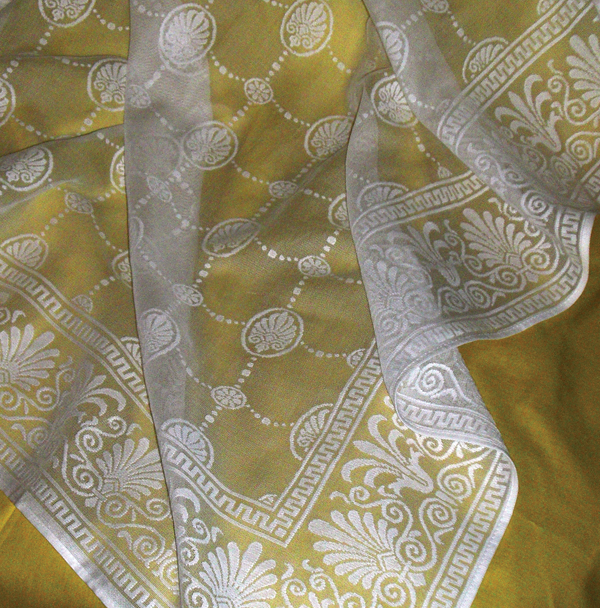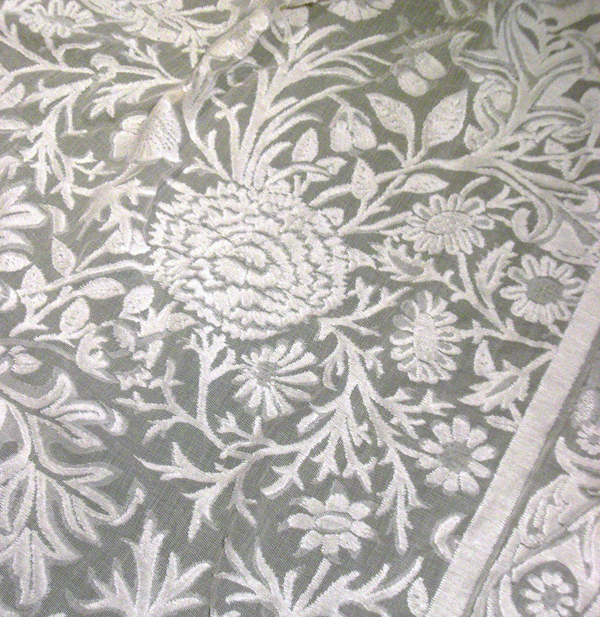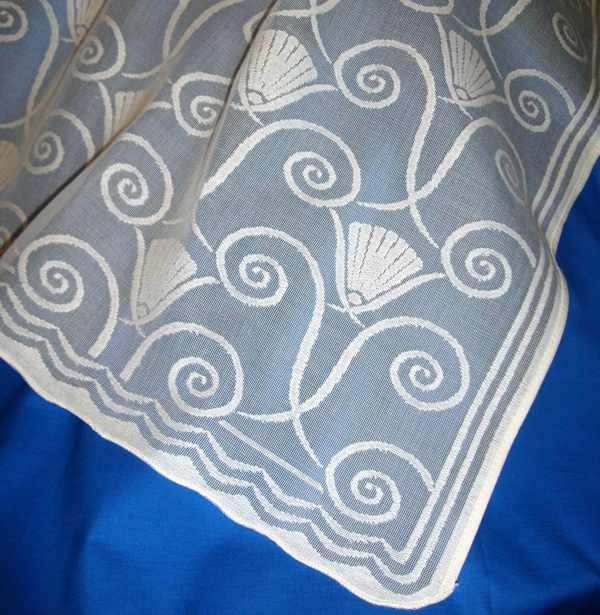Cooper’s Pine Cone pattern is at home in rustic, cottage-style, and Arts & Crafts houses.
My days are often spent on the telephone, guiding clients who I know are standing near a window, atop a ladder (or kitchen chair) with a clacking tape measure in hand. As a designer and merchant of period-inspired lace curtains, I can offer them—and you—help in selecting appropriate window treatments. From 20 years of advice:
Which Pattern?
Many people mistakenly assume that lace curtains are Victorian. Not true: Lace was used at the windows long before Queen Victoria ascended the throne, and lace curtains are still common today, especially in the United Kingdom and Europe.
Although machine-made lace wasn’t available until after the mid-19th century, earlier historical patterns (previously hand-woven) are being reproduced today, suitable for Colonial, Federal, and Greek Revival homes. Down the timeline, Arts & Crafts-era, Art Deco, Elizabethan, and Colonial Revival patterns are being made. Because interior styles evolved, you can choose to coordinate the lace pattern with your furnishings rather than the house.
Shades of Lace
Most lace curtains today are finished in white, natural white (a.k.a. ivory), or ecru. White is bleached, like a new cotton T-shirt. Natural white is unbleached; I tell clients that it looks white until you place it side-by-side with bleached white. Ecru is a darker, almost tan color. All of these, as long as they are cotton, easily can be tea-stained or dyed to a darker shade. Consider that some people find ecru too “yellowy” against white-painted woodwork, while others find white too stark against dark trim.
Which Weave?
Most of your choices have been woven on Madras or Nottingham looms. Richly textured Madras lace is made by an appliqué process wherein a 100-percent cotton scrim is woven, and then the loom passes over it and a pattern is affixed. Finally, the panel is sheared, creating a crisp design. Nottingham is a type of machine-woven lace developed in the 1840s; it’s available in several point sizes that determine the fineness or coarseness of the pattern. Nottingham lace is produced in cotton/polyester blends ranging from 95-percent cotton to all polyester.
Shirred lace panels hung below transom windows lend privacy while admitting plenty of light. (Photo: Carolyn Bates)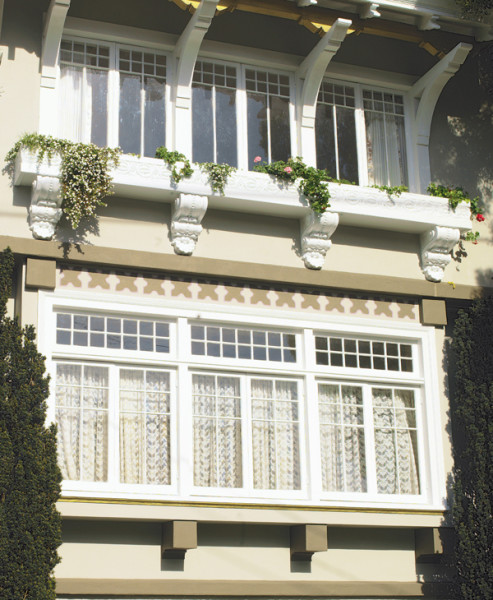
Length and Width
There’s no exact formula; still, conventions exist that differ according to era. For Federal, Greek Revival, romantic (i.e., early to mid) Victorian, and some Colonial Revival styles, window treatments were “fuller” and more gathered. Typically, the ratio of lace was 1½ to two times the width of the window opening—say, 54″ to 72″ of lace (flat width) for a 36″-wide window. Lace panels often hung well below the windowsill, sometimes even pooling onto the floor.
For bungalows and most Colonial Revival houses, and for the styles of the 20th century—Craftsman, Deco, mid-century modern—window treatments were hung “flatter” with less gathering. The cloth to window ratio is not more than 1½ times; for many patterns, the preference is one to 1¼ times, or 36″ to 45″ of lace for a 36″ window. By now curtains were shorter, stopping at or near the windowsill or apron. I offer custom shortening, as do some other vendors; the panels can be shortened from the top to preserve an ornamental bottom border.
Cleaning and Care
Unless you have some special (dirty or dusty) circumstance, once a year is more than enough. In the interim, you might shake the curtains out or gently vacuum them (using the soft brush attachment). Manufacturers recommend dry-cleaning, although my clients have found that washing their panels in cold water with a mild detergent, by hand or on the machine’s delicate cycle, works well. High-efficiency washers will deliver the clean curtains to you barely damp. Never put cotton lace curtains in the dryer! Simply hang them up, barely damp, back on their rods. Don’t hang lace by clothespins, and don’t drape it over a clothesline, because, as the rope sags, the lace may become distorted. Straighten them while they are hanging by lightly spritzing them with water, then gently tugging and smoothing the fabric by hand. Cotton lace will shrink slightly after washing. (Damp-ironing may mitigate shrinkage.) You can lower the rod or hang the curtain through the header hem instead of the lower rod pocket.
In a Victorian vignette, lace panels hang to the floor, tied back over a fancy roller shade. (Photo: Paul Rocheleau)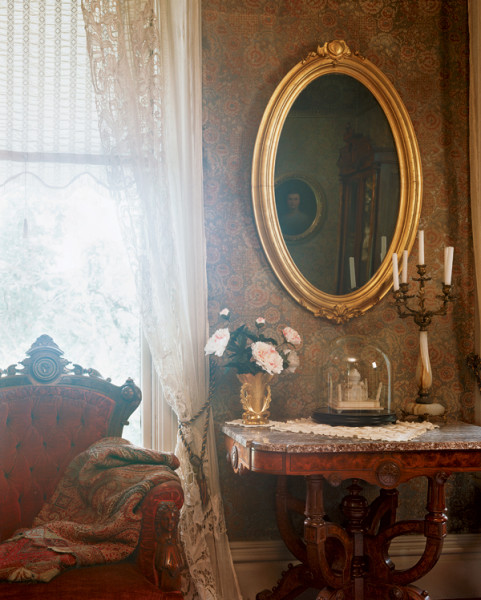
Hanging Curtains
The simplest way to hang a lace curtain is with an adjustable spring-tension rod, readily available at hardware stores. To mount the curtains on the face of the woodwork, you can find inside- or outside-mount café rods in a variety of finishes. Sash rods that fit close to the glass are preferred for door and sidelight curtains, where you might want a bottom rod pocket sewn into the curtains.
Sources
Cooper’s Cottage Lace: Author Dan Cooper founded the company to extend the offerings available in cotton Madras lace. Besides his own adaptations, he’s invited some of today’s best revival artists to interpret Aesthetic and Arts & Crafts movement, Prairie School, Art Deco, neoclassical, and Colonial Revival designs. His 16 (and counting) patterns are 100-percent cotton Madras lace woven in Scotland, available as curtain panels (in many sizes and widths), valances, and table scarves.
Bradbury & Bradbury: Lace curtains (Grecian, Eastlake, Regency, Art Deco) designed by Bradbury & Bradbury Art Wallpapers president Steve Bauer and produced by Cooper complement some of the wallpaper patterns.
J.R. Burrows & Co.: Nottingham Victorian lace curtains (8-, 10-, and 14-point) and Madras muslin curtains in a unique range from Renaissance Revival style to designs by C.F.A. Voysey and Candace Wheeler.
London Lace: Nottingham lace and cotton Madras lace from Scotland in historical and contemporary patterns.
Heritage Lace: Vintage-look patterns among many styles; 100-percent polyester, made in America.



